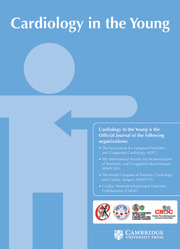No CrossRef data available.
Article contents
Unexpected cardiac interventions including takedown after Glenn surgery: analysis of the Society of Thoracic Surgeons Congenital Heart Surgery Database
Published online by Cambridge University Press: 03 February 2025
Abstract
Glenn procedure carries low morbidity and mortality within stages of single-ventricle palliation. However, some patients with Glenn failure need a stage reversal, while others require unanticipated surgical interventions. Our understanding of perioperative factors and outcomes associated with such unexpected interventions is extremely limited.
Patients who underwent unexpected surgery after the Glenn procedure between January 2010 and December 2019 within the Society of Thoracic Surgeons Congenital Heart Surgery Database (STS-CHSD) were identified with a subgroup analysis of those reverting to stage I physiology. Patient’s requiring reversal to stage I palliation were matched 1:5 with controls. Multivariable logistic regression analysis was performed to evaluate risk factors for reintervention.
A total of 16,913 patients underwent Glenn procedure with 1221 (7.2%) requiring unexpected cardiac surgical intervention and 95 (0.56%) patients required takedown to a stage I. Significant clinical and operative risk factors were identified for such unexpected interventions.
The overall mortality after Glenn procedure was 1.2%, while mortality after unexpected reintervention was 6.6% at 30 days and after Glenn takedown was 27.5% at last follow-up. Unexpected surgical intervention and right ventricular dominance were significant risk factors for mortality.
Unexpected reinterventions, including need for takedown after the Glenn procedure, are associated with significantly higher mortality. Further studies should focus on improving our patient selection, understanding the risk factors mechanistically, including impact of the right ventricle as systemic ventricle in order to avoid need for unexpected surgical interventions.
- Type
- Original Article
- Information
- Copyright
- © The Author(s), 2025. Published by Cambridge University Press



